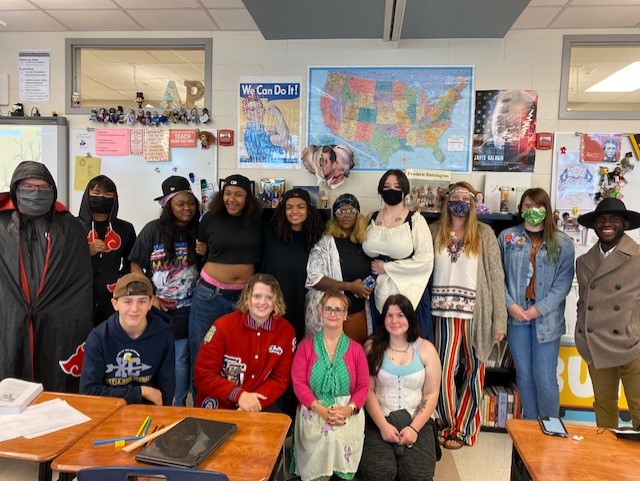Halloween Around The World
From Australia to Ireland to Portugal, everyone celebrates Halloween differently. Dive into the rich culture of Halloween around the world.
World Honors Block picked a class costume: decades; front row: Ben Ticgelaor, Jordan McManus, Susie Adams, Abi Henderson; second row: Josh Brown, Alex Inn, Terica Kimble, Ti’Aisha Harris, Aaliyah Beck, Kayiona Lilly, Faith Wathen, Anne Borgmeyer, Anna Wright, and Patrick Nkongoro.
Nov 2, 2021
From Australia to Ireland to Portugal, everyone celebrates Halloween differently. Dive into the rich culture of Halloween around the world.
Every year, millions of Americans get ready to celebrate Halloween by dressing up in fun and spooky costumes, decorating yards and houses, carving pumpkins, throwing themed parties, and going door to door for candy. Halloween has always been seen as more of an American holiday, despite it not even being considered a national holiday, but it is celebrated in different ways all around the world, and didn’t even originate in the U.S.
Ireland is where it all started. Halloween originated with the ancient Celtic festival of Samhain, where people would light bonfires and wear costumes to ward off ghosts and celebrate the new year. The Celts’ New Year was on Nov 1, and they believed that on New Year’s Eve, the realms between the worlds of living and dead would blur. To combat this, they’d have huge, sacred bonfires, burn crops, sacrifice animals, tell fortunes, and wear costumes made of animal heads and skins. Bonfires were lit to ward off the evil spirits and bad fortune. Embers would be scattered in farmer’s fields to ward off bad luck for the next year.
This sacred festival of Samhain combined with Feralia, a day to commemorate the dead, and Pomona, a day to celebrate the Roman goddess of fruit. The symbol of Pomona is an apple, which is believed to be where the tradition of bobbing for apples comes from. The first jack-o-lanterns, which were hollowed out turnips in Ireland, were brought to bonfires to bring a bit of the bonfire home. Ireland still celebrates Halloween today, with bonfires, costumes, playing games of snap-apple, and eating Barmbrack–a dessert like bread with slices that represent the future.
Less than 400 miles away, the U.K. celebrates Guy Fawkes’ Day. Halloween is celebrated in the U.K., but Guy Fawkes’ Day is a little more significant. Also known as Bonfire Night, it is celebrated on Nov 5, with bonfires and fireworks. In 1605, Guy Fawkes and four other Catholics met at Duck and Drake Inn in London to plan to blow up the Houses of Parliament with gunpowder because of catholic oppression at the time. Fawkes was caught before he could blow up the Parliament because of an anonymous letter, and he was then tortured.
The U.K.’s nearby neighbor, France, celebrates All Saints’ Day, or La Toussaint, on Nov 1. La Toussaint is a national public holiday, where they don’t go to work, but visit graves, attend church, and spend time with family. People honor the dead by putting potted chrysanthemums on graves of loved ones.
Portugal, on the other hand, celebrates Pao-por-Deus, or bread for God on Nov 1 as well. Children under ten-years-old go door to door in the morning, but not wearing costumes or masks like we do in the U.S., reciting a poem in exchange for bread, fruit, or other sweet treats, and in some villages, a Santora cake.
In Mexico, people gather with loved ones to celebrate life and death on El Dia de los Muertos. Through Nov 1st-2nd, there is a belief that the border between the real world and spirit world blur. The souls of the dead awaken and return to our world to drink, dance, and feast. Living family members treat them as honored guests, and leave offerings at graves or ofrendas decorated with candles and bright marigolds. The iconic symbol of Dia de los Muertos is the calavera, or sugar skull. Small skulls typically represent children, while big skulls represent adults.
In some countries, Halloween is slowly being introduced. For example, in Germany, Halloween isn’t celebrated nearly as much, but still celebrated with costumes and parties, but it’s rare to trick-or-treat.
In Australia, there are trick-or-treaters who can go up to doors with an orange balloon to get candy, or lollies. Costumes are more focused on gore and fear, and have a very different feel to it because it is spring on their side of the globe.
In some places, Halloween isn’t celebrated at all. For example, in Rwanda, Halloween is banned. Both public and private celebrations were banned on Nov 1, 2013, by the Ministry of Culture and Sports for being “incompatible” with Rwandan culture.
Halloween isn’t just a U.S. tradition, but one seen all around the world. There are also many other holidays around this time that come from the same roots. All in all, everyone can agree it’s fun to dress up and get free sweets.

